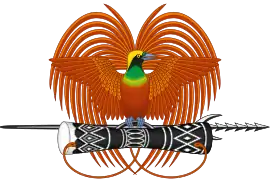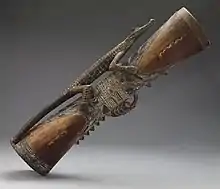Kundu (drum)
Kundu is a pidgin name in Papua New Guinea for an hourglass shaped drum used to accompany formal occasions, religious ceremonies and for celebrations (such as the Sing-sing).[1] This drum is emblematic of Papua New Guinea and it appears on the country's coat of arms.[2]
 Coat of arms for Papua New Guinea, featuring a Kundu drum underneath a Raggiana bird-of-paradise
Coat of arms for Papua New Guinea, featuring a Kundu drum underneath a Raggiana bird-of-paradise Apa drum, Elema culture, Papuan Gulf, Papua New Guinea, [3] This drum also has crocodile-like art
Apa drum, Elema culture, Papuan Gulf, Papua New Guinea, [3] This drum also has crocodile-like art Musicians playing kundu drums at Port Moresby.
Musicians playing kundu drums at Port Moresby. Skin head on a kundu at Museu de la Música de Barcelona
Skin head on a kundu at Museu de la Música de Barcelona.jpg.webp) Papua New Guinea, East Sepik Province, Eastern Iatmul People, circa 1909
Papua New Guinea, East Sepik Province, Eastern Iatmul People, circa 1909 Wabag, Enga Province, Papua New Guinea. Performers at a Sing-sing. The kundus have rings around the skin head, like those made by the Asmat.
Wabag, Enga Province, Papua New Guinea. Performers at a Sing-sing. The kundus have rings around the skin head, like those made by the Asmat._LACMA_M.2008.66.12_(1_of_2).jpg.webp) Warup people, Papua New Guinea, Torres Strait Islands, circa 1850
Warup people, Papua New Guinea, Torres Strait Islands, circa 1850

Characteristics
The sizes of a kundu drum vary. A small finger-drum might measure 30 cm (11.81 in), while a large drum might be 200 cm (74.84 in) long.[4]
The drum is made of carved wood with a possum or lizard-skin drumhead, with some instruments possessing a handle placed on the narrowest part of the drum.[1] Not all kundus have handles, depending on the instruments' style.[4] Traditionally, the lizard skin was held in place with a layer of human blood (as glue).[5]
Depending upon who made it and where it was made, a kundu may be carved plainly, or decorated with "high-relief" carved handles, or relief carvings on the instruments' bodies with open mouthed crocodiles, human faces, dancers, and "spirit figures."[4] Often, the kundu is decorated with animal figures on its edges. On some instruments the handle may have intricate sculpture in (openwork style).
For the Papuans, the sound of the Kundu represents the voice of "spirits".[6][1] Examples of formal religious or civil occasions where one might hear the Kundu include burials, the opening of a new house or the launching of a new boat.[1]
 Papua ceremonial Dema drum, Marind-Anim people
Papua ceremonial Dema drum, Marind-Anim people Marind-Anim ceremonial kundu or Dema drum and Dema costume.
Marind-Anim ceremonial kundu or Dema drum and Dema costume. Large kundu, log drum
Large kundu, log drum
Other names
The hourglass drum is widespread in New Guinea and many surrounding islands, a land with more than 700 different languages.[7] There is no tradition for the instrument in "New Ireland, Manus, Buka / Bougainville or Rossel Island."[4]
While different people's may have the drum, their names and traditions for the instrument vary. Other names include the apa (Elema People, Papua Gulf)[8] and the warup from the Torres Straits.[4]
Tifa
In the Indonesian western end of New Guinea, the tradition of making kundu drums has been affected by the drum-making tradition of other Indonesian Islands, especially the Maluku Islands. The Maluku Iskands drums are known under the name tifa. That name has become used for some New Guinean hourglass drums.
The Asmat people in the Papua province of Indonesia, make hourglass drums covered with decorative symbolic carvings, including the handle.[9] One thing that is different on the Asmat's drums from the kundu drums is that the Asmat secure the skin with a tightly fitted, slip-on ring of rattan, after the skin is glued down.[5][10]
They use tifa for their carved hourglass drum.[7]
Although drums such as the Asmat's are now called "tifa", it may not be appropriate to use the word as a synonym for all kundu drums. The Indonesian word has been applied to hourglass drums, but not exclusively. Other drums that tifa applies to include goblet drums, and to the barrel drums played in the Maluku Islands' Tifa totobuang ensemble and in the Papuan Sing-sing.
.jpg.webp) "Tifa" drum from Manokwari (then called Dorei or Doreh, 1885. The Asmat people are among the inhabitants of Manokwari.
"Tifa" drum from Manokwari (then called Dorei or Doreh, 1885. The Asmat people are among the inhabitants of Manokwari. Biak. Tifa drum. By putting the narrow part of the hourglass near the bottom, this drum begins to resemble a goblet drum.
Biak. Tifa drum. By putting the narrow part of the hourglass near the bottom, this drum begins to resemble a goblet drum. Tifa drums at a Papuan Sing-sing.
Tifa drums at a Papuan Sing-sing. Maluku Islands, Indonesia. Tifa drum (also tiwa and tiva.)
Maluku Islands, Indonesia. Tifa drum (also tiwa and tiva.)
See also
- Tifa, article about the Tifa in Indonesian Wikipedia. Indonesian name sometimes applied to Kundu or Kundu-like drums.
- Music of Papua New Guinea
- Hand drums
- New Guinean Garamut drums (German Language Wikipedia Article)
External links
References
- "Hand drum (kundu), 20th century". Minneapolis Institute of Art.
- "Wooden sculpture depicting the Papua New Guinea Coat of Arms".
This wooden carving depicts the current Papua New Guinea emblem/coat of arms. The new emblem was created as a result of the National Identity Ordinance that passed into law in 1971. The emblem was retained after Papua New Guinea gained independence in 1975 and is still in use today. The coat of arms depicts a Bird of Paradise, traditional spear, and Kundu drum.
- Website: new-guinea-tribal-arts.com late 19th century.
- Richard Aldridge. "Kundu Drums". new-guinea-tribal-arts.com.
- HolmesMuseumAnthro. "Asmat Drum New Guinea (Part 2 of 2)".
In the summer of 2007 two members of the Holmes Museum of Anthropology at Wichita State University traveled to the Asmat region of New Guinea. They recorded the making of a drum by an Asmat man named Robbie.
- "Kundu hand drum". 25 November 2008.
Papuan musical instruments are resonant instruments that emit rather low-pitched sounds usually representing the voices of spirits. They are played by initiated men and are used in ceremonies.
- HolmesMuseumAnthro. "Asmat Drum New Guinea (Part 1 of 2)".
In the summer of 2007 two members of the Holmes Museum of Anthropology at Wichita State University traveled to the Asmat region of New Guinea. They recorded the making of a tifa drum by an Asmat man named Robbie.
- "Apa, 19th century, Papua New Guiney". Metropolitan Museum of Art.
Single-headed, hourglass-shaped drums...found only in Melanesia. In New Guinea and surrounding islands they are called by various names including apa and kundu ...drumheads are made of reptile skin in the lowlands and of opossum hide in the highlands.
- Stichting Papua Erfgoed. "Papua, Asmat, drum tifa (110x19x25)".
[Photograph of an Asmat drum]
- Carsten ten Brink. "The drum Uwus village, Asmat Region, West Papua, Indonesia".
[Photo of the drumhead on an Asmat tifa, with rattan ring and waxy drops (that change the sound of the drumhead.)]
